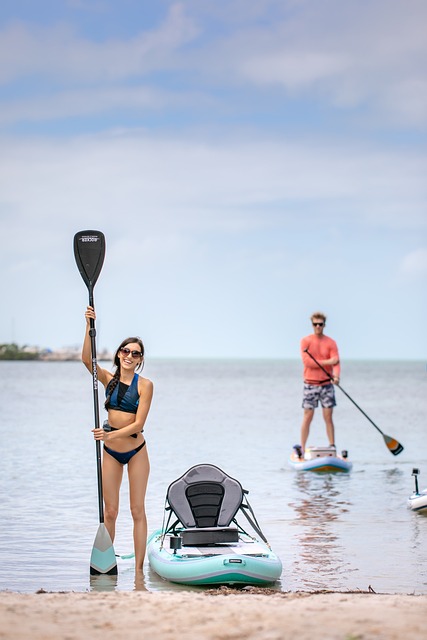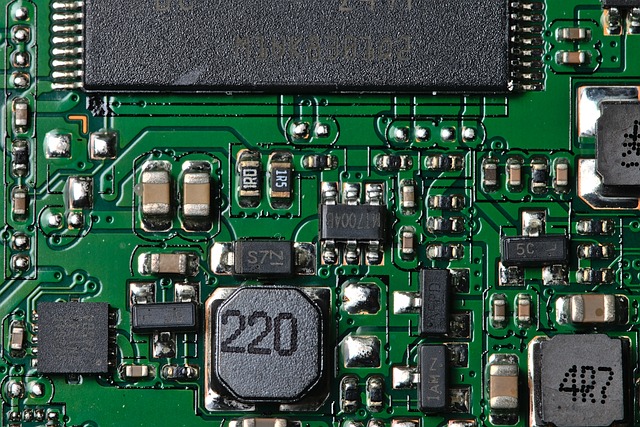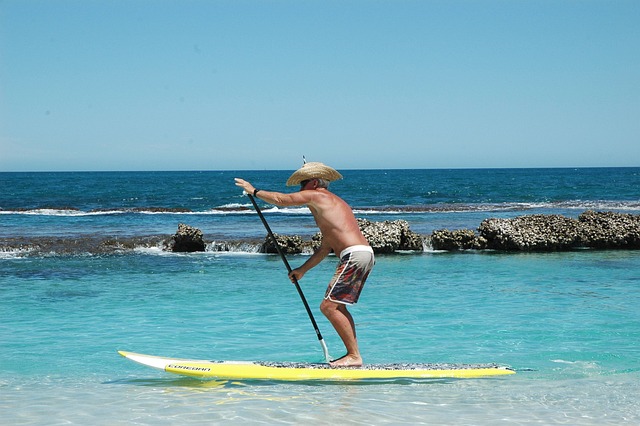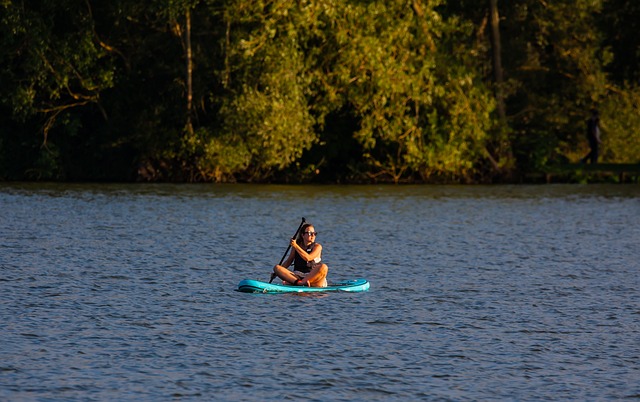When it comes to choosing the best inflatable paddle board (iSUP), stiffness is paramount for an optimal paddling experience. A rigid board ensures stability and tracking, which are crucial for maintaining a straight course with precision. This is particularly important for longer distances or in windier conditions where a softer board might veer off course. The leading iSUPs on the market, such as the iROCKER All-Around and the Red Paddle Co 11'3" Sport, excel in rigidity and are designed to offer performance that rivals traditional hardboards. They provide a stable platform suitable for various water conditions, from serene lakes to challenging ocean waves. These high-quality inflatable boards are engineered with advanced materials and construction techniques, like the iROCKER's triple fusion composite system and Red Paddle Co's MSL fusion process, which contribute to their exceptional stiffness and overall user satisfaction. The best inflatable paddle boards offer a compromise between the convenience of inflation and deflation for transport and storage, and the performance and feel of a hardboard, making them an excellent choice for paddlers who value both practicality and high-performance on the water.
Exploring the dynamics of stiffness in inflatable paddle boards (iSUPs) has become a cornerstone for enthusiasts seeking optimal performance on the water. This article delves into the nuances of material selection, innovative construction methods, and the critical practice of proper inflation and maintenance that contribute to a board’s rigidity. We will evaluate top-rated inflatable paddle boards, emphasizing those renowned for their superior stiffness, and contrast their design with traditional hardboards. Understanding how stiffness influences user experience is paramount, as it directly affects the responsiveness and enjoyment one derives from their time on the water. Join us as we navigate the best inflatable paddle board options and ensure your next paddling adventure is as smooth and efficient as possible.
Understanding Stiffness in Inflatable Paddle Boards: The Role of Material and Design

Inflatable paddle boards have gained popularity among paddlers for their versatility and portability. When evaluating the best inflatable paddle board, it’s crucial to consider how stiffness impacts performance on the water. Stiffness in these boards is not merely a function of materials but also the result of meticulous design and engineering. High-quality inflatable paddle boards feature reinforced layers of PVC or drop-stitch construction that enhance rigidity, ensuring a more comfortable and responsive ride. The design includes various factors such as thickness, width, and the distribution of air pressure across the board. These elements work in tandem to maintain an optimal balance between flexibility and rigidity, which is essential for gliding efficiently through different water conditions without unnecessary bounce or distortion.
Advancements in materials science have led to the development of newer, more durable fabrics that contribute to the stiffness of inflatable paddle boards. The best inflatable paddle board models often incorporate these high-tech materials into their design, resulting in a product that can withstand various environmental factors while maintaining its shape and structure. Additionally, the design process incorporates strategic air chamber placement and fin configuration to further enhance the board’s performance. This careful consideration of both material composition and structural layout is what distinguishes top-tier inflatable paddle boards from their less robust counterparts, ensuring that users enjoy a stable and satisfying experience on the water, regardless of the board’s inflation level.
Key Factors to Consider When Selecting the Best Inflatable Paddle Board

When the term “stiff design” is mentioned in the context of inflatable paddle boards, it refers to the rigidity or firmness of the board when fully inflated. This characteristic is paramount for both performance and user experience, as a stiffer board provides better tracking, maneuverability, and responsiveness, much like a hardboard. To select the best inflatable paddle board (IPB), several key factors must be considered. Firstly, material quality significantly influences stiffness; high-quality materials like PVC or reinforced drop-stitch constructions tend to yield stiffer boards. The thickness of the board also plays a role, with thicker boards generally offering more stiffness. Additionally, width and length affect stability and glide, respectively. A wider board will be more stable, while a longer board will cover greater distances with each stroke. Inflatable paddle boards should also have multiple air chambers for safety and buoyancy; some models come with a traction pad, handles, bungee cords, and fins, all of which can enhance the user’s experience. Consider the intended use of the board—whether it’s for touring, yoga, fishing, or recreation—as this will influence the shape and features that best suit your needs. Lastly, the brand’s reputation for quality and customer support can be a deciding factor in choosing the best inflatable paddle board, ensuring durability and longevity of your investment. By carefully evaluating these factors, you can select an IPB that provides the stiffness and performance necessary for an enjoyable experience on the water.
Innovative Construction Techniques for Enhanced Rigidity in Inflatable SUPs

The quest for enhanced rigidity in inflatable stand-up paddle boards (SUPs) has led to significant advancements in construction techniques, ensuring that even the best inflatable paddle board can rival the performance of traditional hardboards. One such innovative approach is the multi-layered laminated structure, where multiple materials are fused together, providing a robust and rigid foundation that withstands environmental elements and maintains shape under varying pressure levels. This construction not only improves the board’s overall durability but also its ability to stay firm when inflated, offering paddlers a stable platform for various water activities.
Furthermore, manufacturers are incorporating high-density drop stitching within these SUPs, which significantly contributes to their rigidity and buoyancy. The fine threads interwoven between the top and bottom chambers create an internal framework that stiffens upon inflation, ensuring a board that remains resilient under weight and water conditions. This technology, when combined with reinforced rails and a high-pressure valve system, results in inflatable paddle boards that are as rigid and responsive as their hardboard counterparts, delivering an optimal paddling experience for enthusiasts of all levels.
Top-Rated Inflatable Paddle Boards with Superior Stiffness

When venturing into the realm of paddle boarding, inflatable options have become a popular choice for their portability and durability. Among the plethora of inflatable paddle boards available, discerning the best inflatable paddle board often hinges on factors such as stiffness and performance on the water. A top-rated model that consistently stands out for its superior stiffness is the iROCKER All-Around Inflatable Paddle Board. This board boasts an advanced construction with a triple fusion composite system, which not only contributes to its rigidity but also ensures it can handle various conditions without compromising on stability or glide. The iROCKER’s sturdiness is unmatched, providing paddlers with the confidence to explore diverse environments, from calm lakes to surfing in small waves.
Another exemplary choice for those seeking the best inflatable paddle board with exceptional stiffness is the Red Paddle Co 11’3″ Sport Inflatable Paddle Board. This model utilizes an MSL (Monocoque Structural Laminate) fusion process, which involves a high-tech reinforced polymer drop-stitch core surrounded by a dual-layer composite skin. The result is a board that’s both lightweight and incredibly stiff, offering superior tracking and performance. The Red Paddle Co board is engineered to deliver the feel of a hardboard with the added benefits of an inflatable design. Both the iROCKER and the Red Paddle Co are designed for riders looking for a reliable, high-performance inflatable paddle board that won’t easily bend or flex under their weight, ensuring an enjoyable and smooth experience on the water.
The Importance of Proper Inflation and Maintenance for Maintaining Stiffness

When it comes to maximizing the performance and longevity of an inflatable paddle board, proper inflation and regular maintenance are key factors in maintaining its stiffness. Inflating your best inflatable paddle board to the recommended pressure is not just a matter of safety; it’s fundamental for the board’s structural integrity and overall functionality. A board that is under-inflated can become distorted, compromising its glide and response time. Conversely, over-inflating beyond the optimal PSI can lead to an excessively rigid surface, which may be uncomfortable for the paddler and potentially damage the board’s seams and materials over time.
To ensure your inflatable paddle board retains its stiffness, it’s crucial to regularly inspect and maintain your gear. This includes checking the board for any signs of wear or damage after each use, as well as ensuring that all valves, fins, and seams are intact and functioning correctly. Regularly cleaning the board with freshwater after every outing helps prevent the accumulation of dirt and grime, which can affect its rigidity and performance. Additionally, using a high-quality inflation pump specifically designed for inflatable paddle boards can help achieve and maintain the ideal pressure, enhancing both the user’s experience and the board’s durability. By adhering to these maintenance practices, paddlers can ensure that their best inflatable paddle board remains stiff and responsive, providing a reliable platform for exploration and enjoyment on the water.
Comparing Stiff Design: Hardboards vs. Best Inflatable Paddle Boards

When evaluating the performance and comfort of paddle boards, the design plays a critical role in determining the suitability of each board for different users and conditions. Hardboards, traditionally crafted from solid materials like polyethylene or fiberglass, offer a stiff and stable platform due to their fixed shape and composition. They are known for their durability and can handle a variety of paddling environments, including calm lakes and moderate ocean waves. However, their rigidity comes at a cost, as transporting and storing these larger, heavier boards can be less convenient compared to inflatable options.
In contrast, the best inflatable paddle boards (iSUPs) present a compelling alternative with enhanced portability and versatility. These boards are constructed from multiple layers of PVC-coated fabric, which, when inflated, provide a surprisingly rigid surface comparable to that of hardboards. The inflation process allows paddlers to adjust the firmness to suit their weight and preferred ride characteristics, offering a personalized experience. Moreover, iSUPs can be easily rolled up and transported in a compact bag, making them ideal for those with limited storage space or who travel frequently. This design innovation has made inflatable paddle boards one of the most popular choices among enthusiasts seeking a balance between performance and practicality. When comparing stiff design between hardboards and the best inflatable paddle boards, it’s evident that advancements in iSUP technology have significantly narrowed the gap in terms of rigidity and overall functionality, making them a strong contender for paddlers of all levels.
User Experience: How Stiffness Affects Performance and Enjoyment on the Water

When considering the user experience associated with inflatable paddle boards, such as the “best inflatable paddle board” models on the market, stiffness plays a pivotal role in both performance and enjoyment on the water. A well-designed inflatable paddle board should maintain a balance between rigidity and flexibility to ensure a smooth glide over various water conditions. Stiffness is particularly crucial for stability and tracking; it allows paddlers to navigate with precision and maintain a straight course without excessive effort. The best inflatable paddle boards achieve this through advanced materials and construction techniques, often featuring multiple layers of PVC-coated fabrics reinforced with drop-stitching that creates a rigid yet lightweight structure. This rigidity minimizes board flex under the paddler’s weight, which can otherwise lead to fatigue and reduced efficiency during long paddles. Moreover, a stiff board translates to a more enjoyable experience as it enhances the responsiveness of the board to paddle strokes, offering a more connected and intuitive interaction with the water. Paddlers can confidently maneuver through waves, winds, and currents, making the best inflatable paddle boards an excellent choice for both recreational and performance-oriented users seeking a reliable and responsive experience on the water.
